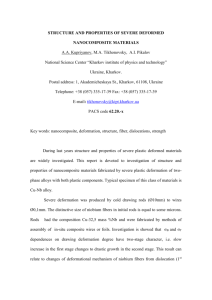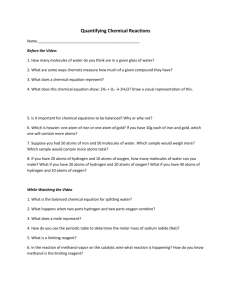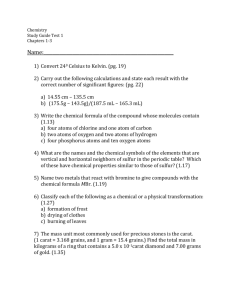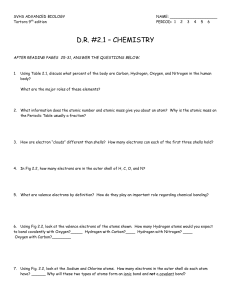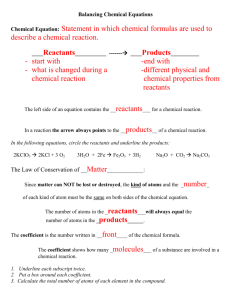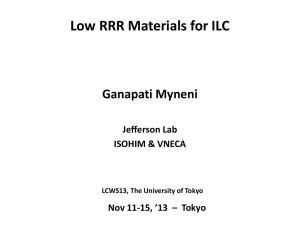Публикация доступна для обсуждения в рамках
advertisement
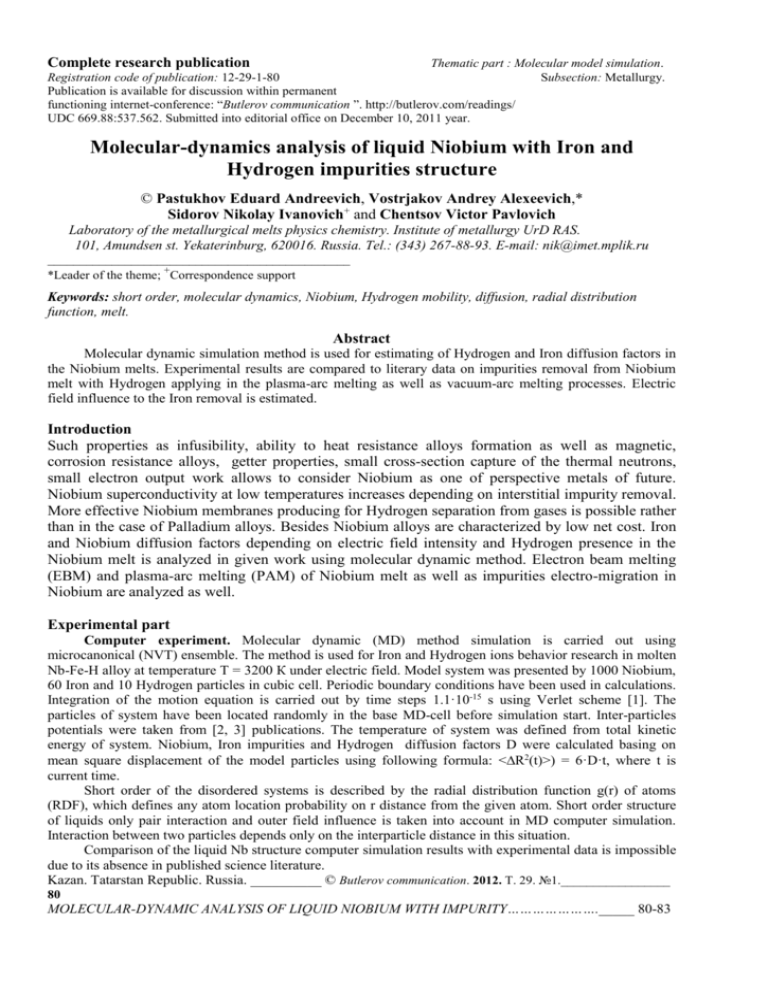
Complete research publication Thematic part : Molecular model simulation. Registration code of publication: 12-29-1-80 Subsection: Metallurgy. Publication is available for discussion within permanent functioning internet-conference: “Butlerov communication ”. http://butlerov.com/readings/ UDC 669.88:537.562. Submitted into editorial office on December 10, 2011 year. Molecular-dynamics analysis of liquid Niobium with Iron and Hydrogen impurities structure © Pastukhov Eduard Andreevich, Vostrjakov Andrey Alexeevich,* Sidorov Nikolay Ivanovich+ and Chentsov Victor Pavlovich Laboratory of the metallurgical melts physics chemistry. Institute of metallurgy UrD RAS. 101, Amundsen st. Yekaterinburg, 620016. Russia. Tel.: (343) 267-88-93. E-mail: nik@imet.mplik.ru _______________________________________________ *Leader of the theme; +Correspondence support Keywords: short order, molecular dynamics, Niobium, Hydrogen mobility, diffusion, radial distribution function, melt. Abstract Molecular dynamic simulation method is used for estimating of Hydrogen and Iron diffusion factors in the Niobium melts. Experimental results are compared to literary data on impurities removal from Niobium melt with Hydrogen applying in the plasma-arc melting as well as vacuum-arc melting processes. Electric field influence to the Iron removal is estimated. Introduction Such properties as infusibility, ability to heat resistance alloys formation as well as magnetic, corrosion resistance alloys, getter properties, small cross-section capture of the thermal neutrons, small electron output work allows to consider Niobium as one of perspective metals of future. Niobium superconductivity at low temperatures increases depending on interstitial impurity removal. More effective Niobium membranes producing for Hydrogen separation from gases is possible rather than in the case of Palladium alloys. Besides Niobium alloys are characterized by low net cost. Iron and Niobium diffusion factors depending on electric field intensity and Hydrogen presence in the Niobium melt is analyzed in given work using molecular dynamic method. Electron beam melting (EBM) and plasma-arc melting (PAM) of Niobium melt as well as impurities electro-migration in Niobium are analyzed as well. Experimental part Computer experiment. Molecular dynamic (MD) method simulation is carried out using microcanonical (NVT) ensemble. The method is used for Iron and Hydrogen ions behavior research in molten Nb-Fe-H alloy at temperature Т = 3200 К under electric field. Model system was presented by 1000 Niobium, 60 Iron and 10 Hydrogen particles in cubic cell. Periodic boundary conditions have been used in calculations. Integration of the motion equation is carried out by time steps 1.1·10-15 s using Verlet scheme [1]. The particles of system have been located randomly in the base MD-cell before simulation start. Inter-particles potentials were taken from [2, 3] publications. The temperature of system was defined from total kinetic energy of system. Niobium, Iron impurities and Hydrogen diffusion factors D were calculated basing on mean square displacement of the model particles using following formula: <R2(t)>) = 6·D·t, where t is current time. Short order of the disordered systems is described by the radial distribution function g(r) of atoms (RDF), which defines any atom location probability on r distance from the given atom. Short order structure of liquids only pair interaction and outer field influence is taken into account in MD computer simulation. Interaction between two particles depends only on the interparticle distance in this situation. Comparison of the liquid Nb structure computer simulation results with experimental data is impossible due to its absence in published science literature. Kazan. Tatarstan Republic. Russia. __________ © Butlerov communication. 2012. T. 29. №1._________________ 80 MOLECULAR-DYNAMIC ANALYSIS OF LIQUID NIOBIUM WITH IMPURITY…………………._____ 80-83 Results and its discussion Fig.1 demonstrates g(r) for Nb and Nb-Fe-H melts at 3200 K temperature, obtained by MD method. It should be noted, that most probable interatomic distance (0.258 nm) in the first coordination sphere for molten Niobium (curve 1) approximates to the covalent radii sum (0.134 nm) of Niobium atoms. Small hump is observed on the g(r) curve for Nb melt on the second maximum left side. This data comparison to related values for Niobium crystals (a = 0.3301 nm and Z = 12) proved, that melting go with considerable short order change, and hence interatomic bond character as well. Impurities Fe and H to Nb, as shows curve 2, lead to considerable decreasing of first maximum height, its widening and displacement to the side of lower values of r. First coordination sphere depends on dimensions of atoms included into the alloy content. Niobium atoms have maximal dimension (0.144nm), minimum – Hydrogen Fig.1. Radial distribution function g(r) of Nb (1) and atoms (0.046 nm), mean – Iron atoms (0.126 Nb-Fe-H (2) melts at Т = 3200 К temperature; MDnm). First maximum shift of g(r) to the low model. angles side in the Nb-Fe-H system is related to decreasing of the first coordination sphere radius. Such changing can be explained by considerable changing of the interatomic interaction forces. Fig. 2. demonstrates model system with Iron and Hydrogen evolution based on «momentary snapshots». Several phases of the system developments can be identified during its evolution from liquid state to state of small number of agglomerated particles. Fig. 2 demonstrates Niobium atoms migration in melt volume during 3ps time, when atoms agglomerate and form «islets». This process is stochastic character. Therefore «islets» are different by size and distributed in volume irregularly. Majority of the primary particles have been agglomerated into large clusters already non spherical form (fig. 2b) at the final stage of simulation. Since clusters have been formed due to «covering» of formed outer cavities, then clusters size increasing, seemingly, is related to its surface increasing. It was found, that process time increasing to t = 5 ps, structure of Niobium–Iron–Hydrogen melt, in the most part have been forming into elliptic large clusters (fig. 2.) with Iron atoms inside and Hydrogen atoms round it. Most size cluster, shown on fig. 2b, contains 80% of all atoms in system under simulation. a) b) Fig. 2. Evolution of liquid Niobium with Iron and Hydrogen MD model at T = 3200 K. a) for time t = 3 ps, b) for time t = 5 ps. Fig. 3 presents MD model evolution for liquid Niobium with Hydrogen at t = 10 ps and T = 3200 К. During 10 ps «islets» from Nb atoms became equal size and form structure similar to ordered one. The majority of clusters to this time are disappeared and 90% of all Nb atoms are located in the clusters with no more than 200 atoms size. ©Butlerov Communications. 2012. T. 29. №1.____________E-mail: jornal.bc@gmail.com_____________________ 81 Complete research publication Pastukhov E.A, Vostrjakov A.A, Sidorov N.I and Chentsov V.P. As a result, configuration is formed, containing five regularly located Niobium clusters. Possible long range order in the molten Niobium can be proved also by experimental data on Niobium density in transition from solid to liquid state [4]: melting jump is absent on density curve. Simulation shows, that at 10 ps in molten Nb exist clusters, containing only Nb atoms, and Hydrogen atoms are located among its. Inter-cluster space does not contain Nb atoms; this fact can prove absence of Niobium-Hydrogen interaction in the melt. Fig. 3. Evolution of MD model for liquid Niobium with Hydrogen without Iron at t = 10 ps and T = 3200 K. Fig. 4. Dependence of DNb and DFe on Iron (mas. %) concentration by MD calculation (without Hydrogen and electric field applying). Analogously to simulation of Silicon with Oxygen [5], inter-cluster atoms structuring is observed for liquid Nb in our case. Structuring exists only in Nb without Iron and Hydrogen impurities. Appearance of Fe and Nb atoms leads to disappearance of rigorous inter-cluster structuring. All these facts prove liquid Niobium obtaining qualitatively other structure relatively to crystal state at absolute removal of Iron impurities. Iron and Niobium diffusion factors in the Niobium melt at 3200K temperature with electric field and without it are calculated basing on computer simulation. As MD simulation results prove, electric field (600 V/m) applying to Niobium melt decreases Niobium diffusion factor from 4.97∙10-5 to 1.28∙10-5 cm2∙s-1. Electric field intensity increasing from 600 V/m to 1200 V/m does not lead to DNb changes. The results of DFe and DNb calculations in molten Niobium depending on Fe concentration (c) is illustrated by fig.5. Diffusion coefficient of Nb decreases according to Fe − concentration in Niobium increasing (fig. 4). Hydrogen inducing into Nb-Fe system leads to decreasing of DNb to value 1.38∙10-5 cm2∙s-1. Electric field increasing from 600 to 1200 V/m does not change value of Niobium diffusion coefficient 1.38∙10-5 cm2∙s-1. We carried out calculation of Iron removal rate Fig. 5. Dependence of log(L,M) at T = 3200 K from Niobium considering Iron concentration on Iron impurity concentration decreasing in decrease at beginning middle and finish stage of PAM process. Curve 1 – Langmurian (logL) plasma arc melting process (PAM) with Hydrogen and curve 2 – data [6]. using experimental data [6]. We calculated evaporation intensity L(g/cm2) by Langmuir equation for mean Fe concentration for 15, 90 и 150 minutes of melting [6]. It should be noted (fig. 5), that Fe evaporation intensity from Nb melt according to Langmuir equation coincides with experimental data for PAM [6]. 82 ____________ Vol.29.No.1.P.80-83. http://butlerov.com/___________©Butlerov Communications. 2012 We estimated diffusion layer thickness (x) by equation [7] using experimental dependence CFe on time [6] and diffusion coefficient DFe, calculated by MD method x Cx ,t C0 , 2 D t Fe where х is diffusion layer thickness, t – refining time, C0 and Сх,t – impurities concentration in an initial and refined niobium. Obtained x values for three above indicated time intervals are equal to: 4.8∙10-2, 1.95∙10-2 and 1.67∙10-2 cm. Diffusion layer thickness is close to data [8] by order of value. Conclusions 1. Diffusion coefficients for Nab and Fe dependence on Fe content in Nab by molecular dynamic method are calculated. 2. Evaporation of Fe from liquid Nab is described by Langmuir equation satisfactorily. Proper calculations for 3200K are in good agreement with experimental data on Fe removal from Nb. 3. Structuring of Nb atoms in liquid Nb-H system is proved by molecular dynamic method. Structuring disappears with Fe and H atoms appearance between Nb atoms Acknowledgements Research is carried out with financial support of Minobrnauka. Government contract 16.552.11.7017. Equipment of CKP «Ural- M» is used. References [1] Ver1et L. Computer experiments in classical fluids. Phys. Rev. 1976. Vol.159. №1. P.98-103. [2] Zhou X.W., Wadly H.N.G., Johnson R.A. et. al. Atomic scale structure of sputtered metal multilayers. Acta mater. 2001. 49. P.4005-4015. [3] Rappe А.К., Cascwit С.J., Colwel1 К . S. et al. UFF, a full periodic Table force field for molecular mechanics and molecular dynamics simulalations. J. Am. Chem. Soc. 1992. 114(25). P.10024-10035. [4] Thermophysical Properties Database System (TPDS). Niobium Density (www.aist.go.ip) [5] Galashev A. E. Growth of a Nanocristal in an Oxigen Atmosphere. Computer Simulation. Crystallography Reports. 2002. Vol.47. P.SI69-S176. [6] Mimura К., Isshiki М. Hydrogen Plasma Arc Melting from book. Waseda Y.,Isshiki. Purification process and ultra high purity metals November 28, 2001. P.365. [7] Maksimov E.G., Pankratov O.A. Hydrogen in the metals. UFN. 1975. Vol.116. Issue.3. P.385-412. [8] Belash N.N., Tatarinov V.R., Semenov N.A. Complex alloyage of Uranium in centrifugal casting in Zirconium mould. VANT, series: Physics of radiation damages and radiation materials technology. 2006. №4. (89) P999999.123-127.


